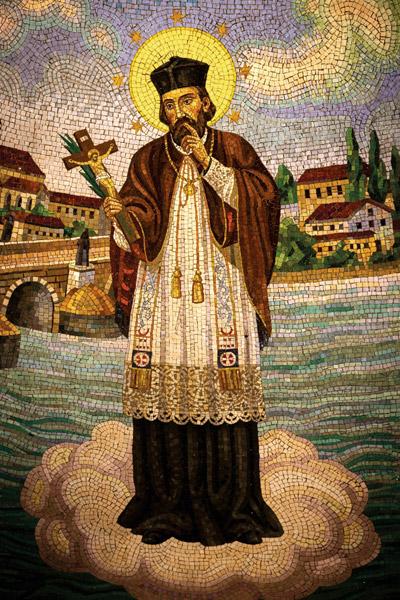
NEW YORK — A symbol of the historical commitment priests have to the seal of confession greets people as they cross the threshold of a Catholic church in Manhattan’s Upper East Side.
Above the door is a stone-carved image of St. John Nepomucene holding two fingers to his lips, signifying that priests must never reveal what is said to them in the confessional, even if that means paying the ultimate sacrifice of death.
This church is named for St. John Nepomucene — considered the patron saint for the seal of confession — and it’s adorned with artwork that tells the story of this 14th-century Bohemian priest who chose death rather than reveal what was said during the sacrament of penance.
His story demonstrates how seriously the Catholic Church takes the privilege between priest and penitent that a member of the clergy is willing to sacrifice his freedom, or even his life, to protect the seal of confession, said Dominican Father Pius Pietrzyk, a canon and civil lawyer who teaches at St. Patrick’s Seminary and University in Menlo Park, Calif.
It also shows that the current struggle for the Church to have governments fully respect the sanctity of the seal of confession is not a new one, Father Pietrzyk told Catholic News Service in a May interview.
St. John Nepomucene was born sometime around 1340 and became a popular priest in what was then known as Bohemia. Ultimately, he was invited to be a confessor at the court of King Wenceslaus IV in Prague.
According to historical accounts, a jealous King Wenceslaus ordered John Nepomucene to tell him what his wife, Queen Johanna, revealed in the confessional and when he refused to break the seal of confession, the ruler made threats of torture and eventually had him bound and thrown off the Charles Bridge in Prague, where he drowned March 20, 1393.
Father John Nepomucene’s martyrdom for the seal of confession was accepted by the Church and he was canonized by Pope Benedict XIII in 1729.
“St. John Nepomucene is a symbol of what all priests know and that is the seal of confession is absolute and the privilege between priest is penitent must be absolute,” said Father Richard D. Baker, pastor of St. John Nepomucene Church in New York City. “What happens there never, never is repeated.”
Father Pietrzyk makes a point of sharing this chapter in Church history with the seminarians he teaches in his penance class at St. Patrick Seminary to help them understand why priests are willing to be martyred to protect the sanctity of confession.
The Code of Canon Law states the penalty for a priest who violates the seal of confession is automatic excommunication, which can only be lifted by the pope himself.
Though St. John Nepomucene is the most well-known martyr for the seal of confession, other priests throughout history were either jailed or condemned to death rather than reveal what was confessed in the sacrament of penance, including three in the 20th century.
St. Mateo Correa Magallanes, canonized by St. John Paul II in 2000, was shot to death in 1927 in Mexico after refusing the orders of Gen. Eulogio Ortiz to reveal the contents of the confessions of imprisoned members of an insurgency movement, the Cristeros.
He was joined by two Spanish priests — Blessed Felipe Ciscar Puig and Blessed Fernando Olmedo — both considered martyrs of the sacramental seal, executed in 1936 for refusing to reveal the contents of confessions of prisoners held during the Spanish Civil War.
Please read our Comments Policy before posting.
Article comments powered by Disqus Make a meaningful confession for Lent — in your car
Make a meaningful confession for Lent — in your car
 Parishes hold activities to observe the Lenten season
Parishes hold activities to observe the Lenten season
 Protecting seal of confession essential for civilized society
Protecting seal of confession essential for civilized society
 Abuse scandals bring challenges to seal of confession
Abuse scandals bring challenges to seal of confession
 Confession is meant to be joyful, not filled with fear
Confession is meant to be joyful, not filled with fear
 'Cabrini' film tells story of saint with great faith
'Cabrini' film tells story of saint with great faith
 Bishop Taylor announces more pastoral appointments
Bishop Taylor announces more pastoral appointments
 Most U.S. Catholics approve of Pope Francis, Pew says
Most U.S. Catholics approve of Pope Francis, Pew says
 Winning directory photo honors Our Lady of Guadalupe
Winning directory photo honors Our Lady of Guadalupe
 St. Joseph a model of solidarity with immigrants
St. Joseph a model of solidarity with immigrants
 Two gifts after Jesus’ death: Virgin Mary and Eucharist
Two gifts after Jesus’ death: Virgin Mary and Eucharist
 Why we have an altar, and not just a communion table
Why we have an altar, and not just a communion table
 Pope: Wars should be resolved through nonviolence
Pope: Wars should be resolved through nonviolence
 Living relationship with Jesus Christ in the Eucharist
Living relationship with Jesus Christ in the Eucharist